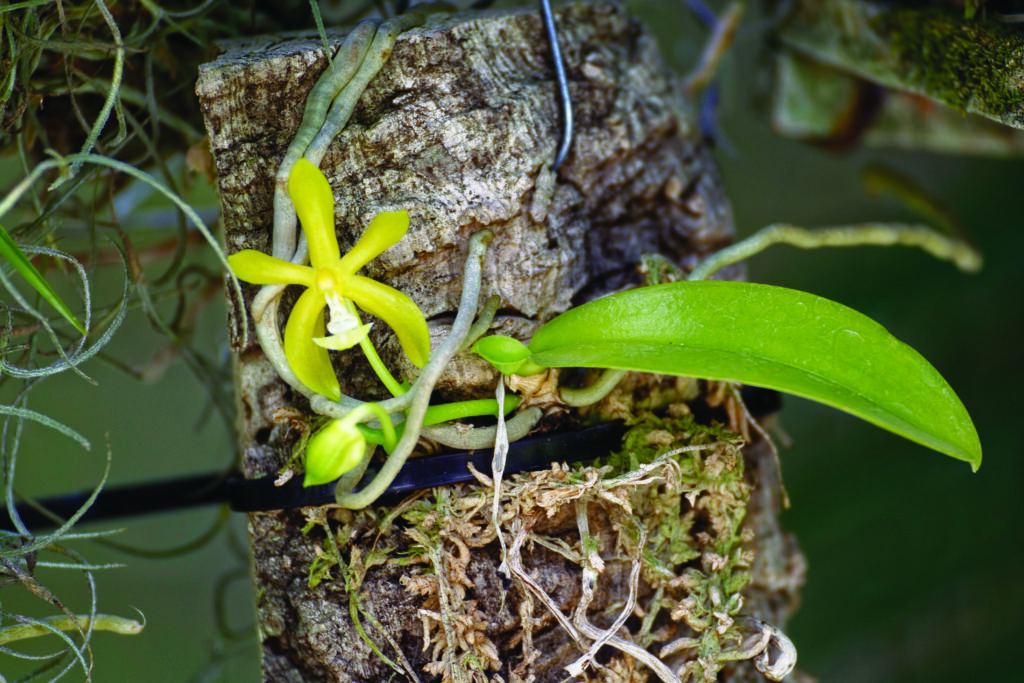
Every week, staff freshen up the LaGrippe Orchid Garden by replacing waning orchids with blooms in their prime.
But what happens to all those spent plants? Are they doomed to the green waste pile? Absolutely not!
At any given time, our staff and volunteers rehabilitate some 3,200 Dendrobium, Vanda, and Oncidium orchids. These are among the colorful, showy plants we use in rotational displays.
The team repots them if needed and feeds them a slow-release fertilizer, along with a weekly dose of liquid nutrition. They water the plants, monitor for pests, remove dead leaves, and wait. The bloom cycle varies from species to species; some flower only once a year.
“When they start showing flower spikes, they are almost ready,” says Javier Blondet, who manages our Lipman Family Farms Greenhouse. Team members return them to the Garden once in bloom.
The orchid rehabilitation saves the Garden thousands of dollars. “Before recycling all these, we had to buy this amount,” says Director of Collections Nick Ewy, standing amid endless rows of orchids. The plants, when properly tended, can thrive for years. You, too, can see your orchids bloom again and again.
Did you know?

You may notice secondary growths called keikis on flower stems. You can remove or leave these on the plant. They can be potted and grown as clones.

Roots may expand beyond these small pots. This exposure does not hurt the plants; in fact, orchids like dry roots. But if you don’t like the aesthetics and choose to bury the roots, take care not to overwater. The roots are accustomed to the open air.

Some species produce pseudobulbs. These are podlike structures at the orchid’s base. Leave those alone; they store water and nutrients. Some will even produce flowers.
Learn how to tend “spent” orchids and prompt new blooms, year after year
Before you begin:
- Research light requirements. Phalaenopsis can tolerate lower light conditions, such as a covered lanai; other species may need more direct sunlight to prompt blooming. If you wish to change your plant’s location, give it time to acclimate to new lighting conditions.
- Choose pots with good drainage and airflow. Plastic pots are OK for indoor use; clay ones will be better outdoors. Hanging baskets are also a good choice. Smaller is better. Orchids prefer confined spaces.
When you are ready:
- Check your orchid’s planting medium. If it looks like it is breaking down or appears wet, replace it with a well-draining orchid mix.
- Remove dead or dry leaves and brown flower spikes. If you use pruning tools, be certain to sterilize the blades between each plant to avoid potential disease spread.
- Water your orchid. When watering, flush the plant with clean, fresh water. Allow the medium to dry between waterings. That “ice cube” rule (give an orchid an ice cube a week) is nonsense, Ewy says. “They’re tropical plants. Don’t put frozen things on tropical plants!”
Ongoing:
- Watch orchids for signs of fungal infections or pests. The Naples Orchid Society (naplesorchidsociety.org) and the St. Augustine Orchid Society website (staugorchidsociety.org) have resources on recognizing and treating disease, along with general care tips.

Want to simplify all this?
“Hang it in a tree,” Blondet suggests. You can use zip ties to affix orchids to trees, placing the side of the plant with the newest growth closest to the trunk or branch. Even though orchids are fairly selfsufficient, you should monitor to ensure they receive adequate sunlight and water.
For orchids and tropical plants to add to your collection, join us for the Naples Flower Show & Garden Market, April 5 & 6, included with Garden admission, free for Members.
The article first appeared in the Spring 2024 issue of Cultivate, the Garden’s magazine.

About the Author
Jennifer Reed is the Garden’s Editorial Director and a longtime Southwest Florida journalist.


